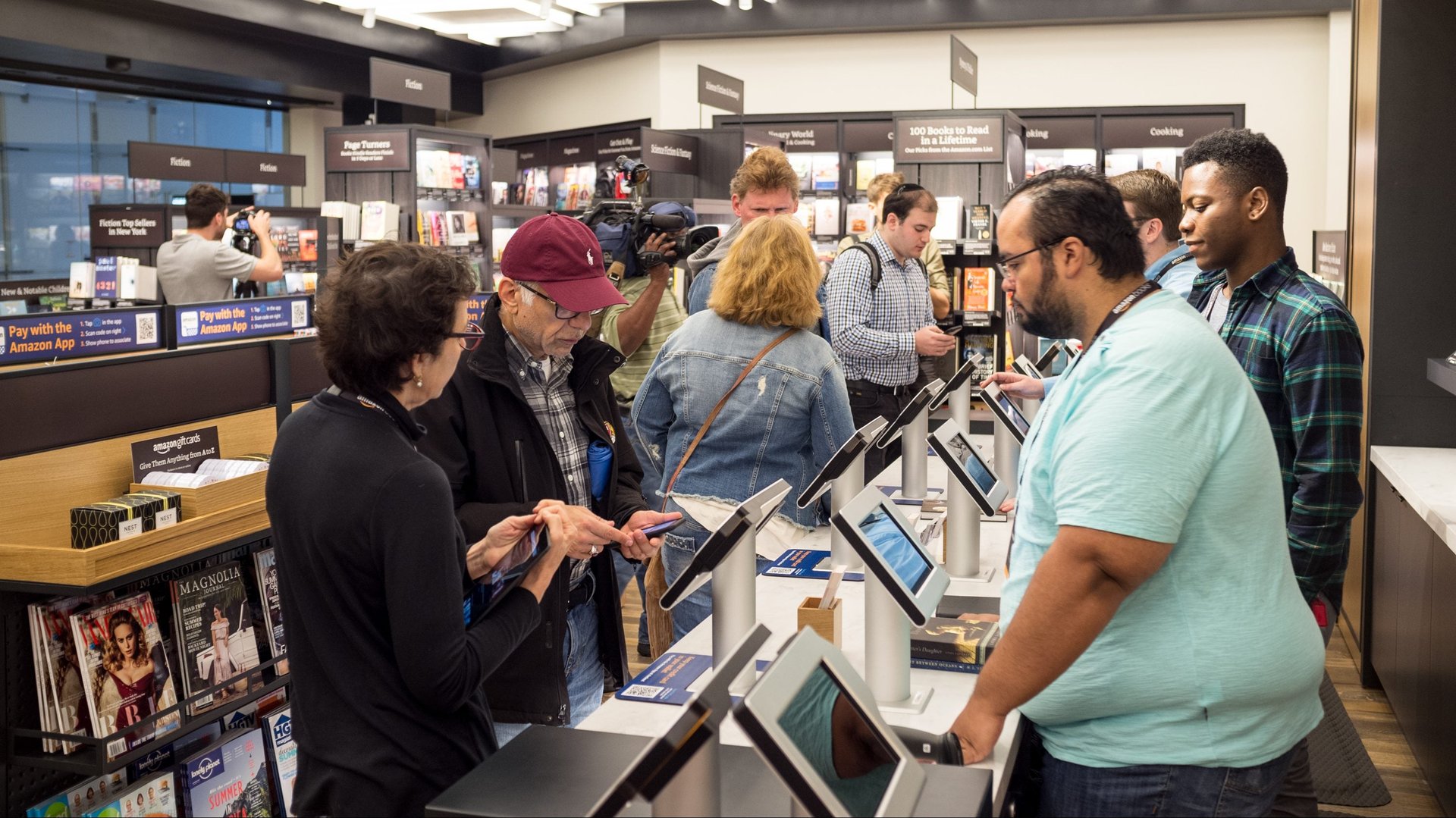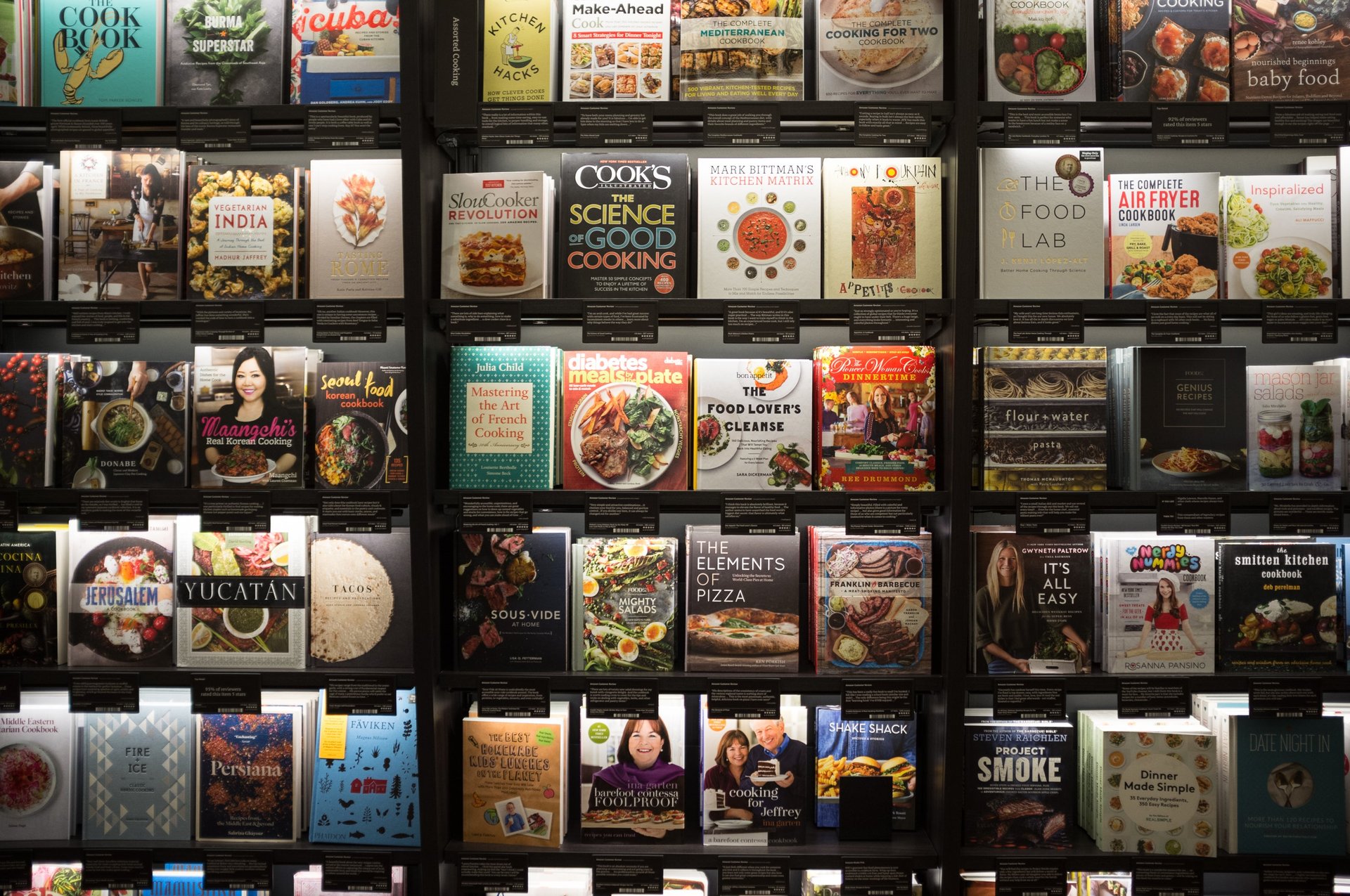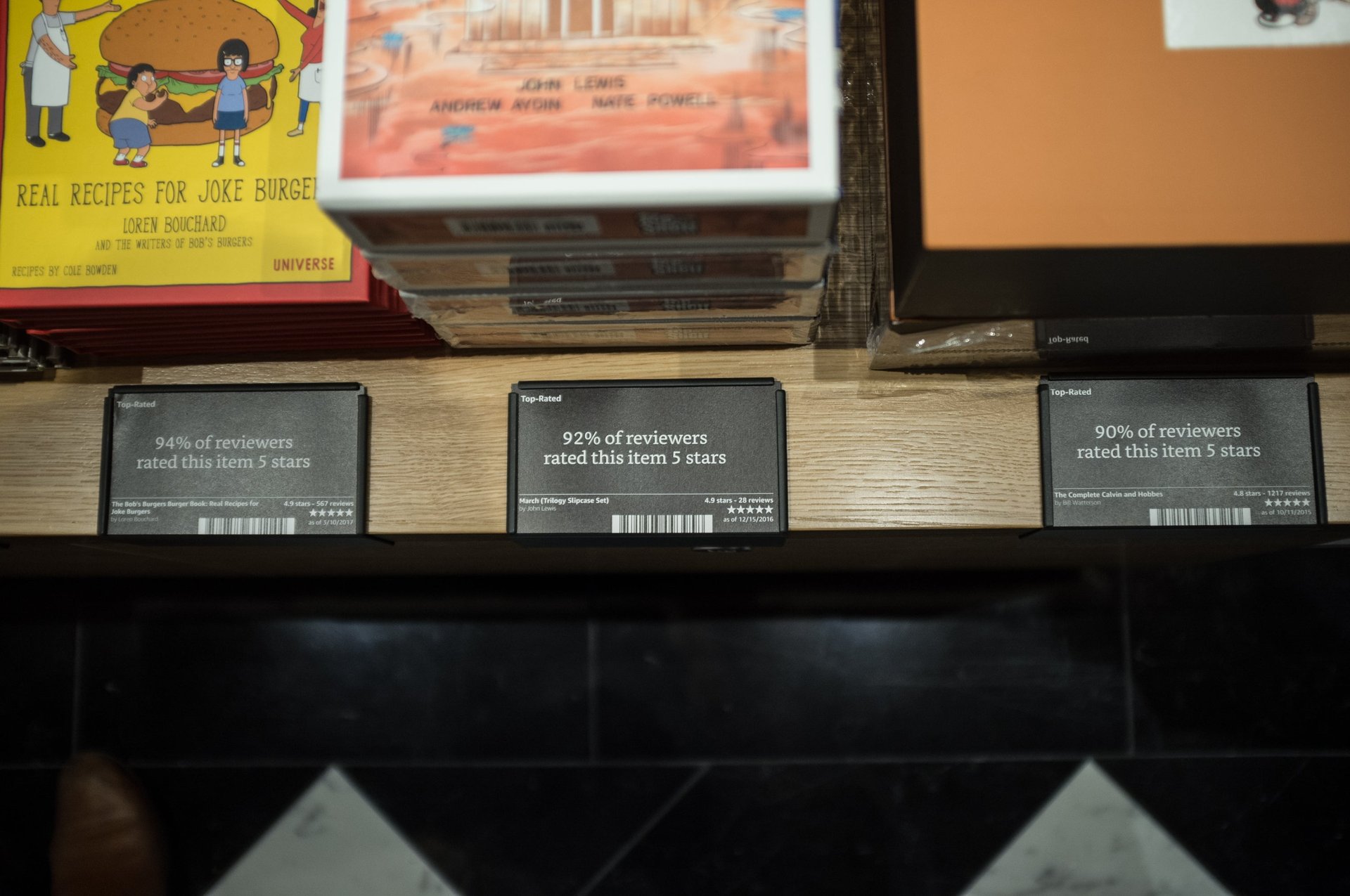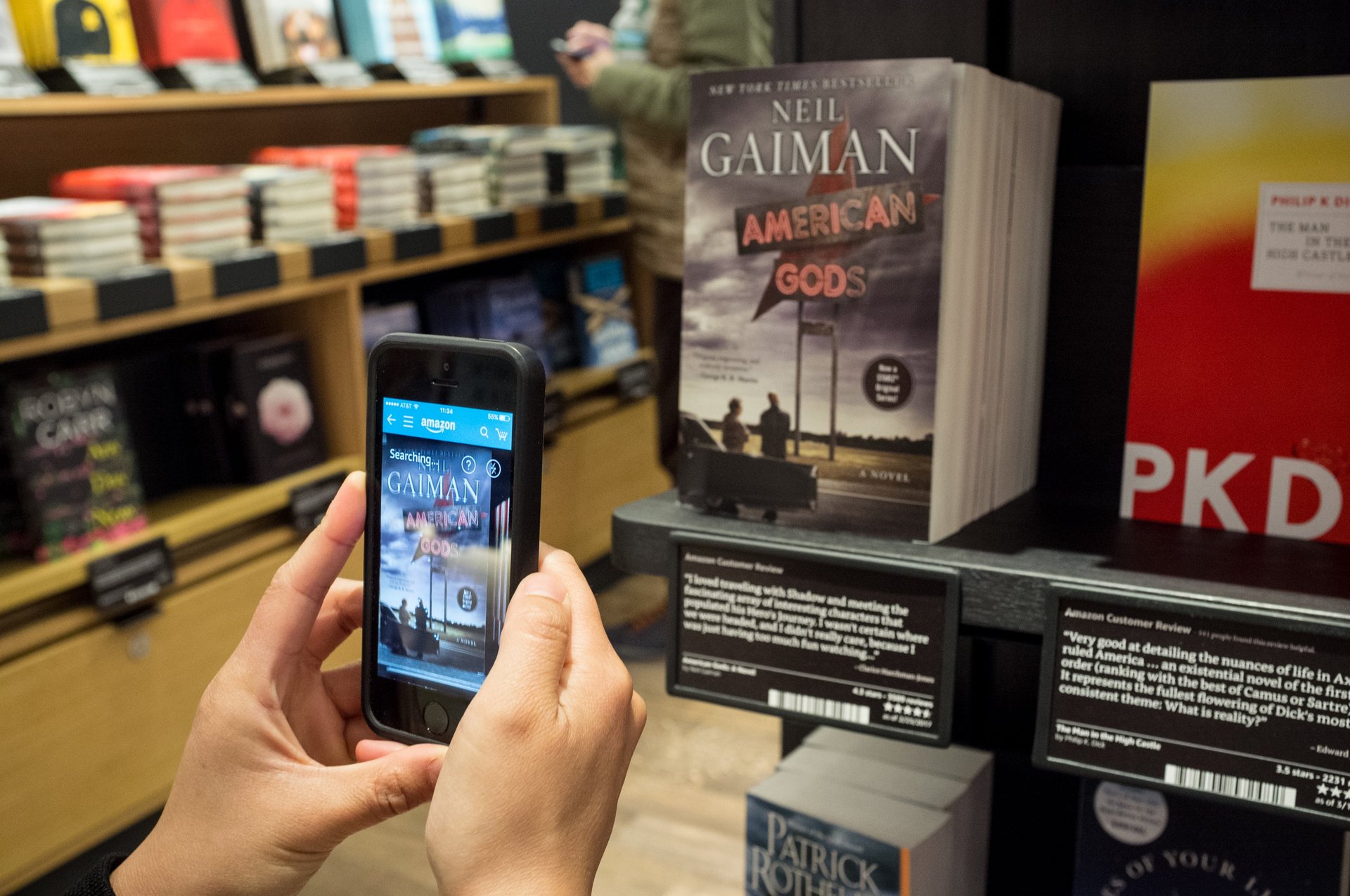Amazon’s first bookstore in New York City sucks the joy out of buying books
The joy of the bookstore lies in what might be called the analog experience of the physical space: Hushed page-flipping; the sound of two covers sliding against each other as a book is returned to its spot on the shelf; the quiet murmur of, “Have you read this one?” Luddites and Twitter junkies alike need insulation from the glare of screens and the sounds of speakers.


The joy of the bookstore lies in what might be called the analog experience of the physical space: Hushed page-flipping; the sound of two covers sliding against each other as a book is returned to its spot on the shelf; the quiet murmur of, “Have you read this one?” Luddites and Twitter junkies alike need insulation from the glare of screens and the sounds of speakers.
Tomorrow (May 25), Amazon will open its first brick-and-mortar bookstore in New York City. The store is on the third floor of a shopping behemoth in Columbus Circle, where a Borders closed its doors in 2011, just blocks away from where a massive Barnes & Noble sold books for 16 years before it, too, closed. A second Manhattan location will open on 34th Street this summer, adding to the 13 total bookstores planned to be open by the end of the year (currently, there are six stores open).
The cashless Columbus Circle store is founded on Amazon’s belief that people will want to discover (and buy) books that are rated highly on Amazon.com, with a barrage of in-person signs and data-driven shelving choices. But buying a book in the store is actually more expensive than purchasing on the site if you’re not a Prime member. The upshot is that, while the physical store succeeds as an ad for a Prime membership, it fails to be joyful, or even effective, as a bookstore.
The store is small—about 4,000 sq ft, compared to Barnes & Noble’s typical 25,000. The shelves are tidy, because the books are placed with their covers facing out, meaning the store contains about half of what it could if the books were arranged spines-out—8,000 titles compared to the 3,000 it carries, according to the store.
In the case of children’s books and cookbooks, which comprise two substantial sections of the store, that’s a good thing. Thick cookbooks with handsome covers benefit from being turned out.

But for the most part, the layout creates clutter that mirrors Amazon’s own site, except without the ease of actually getting the book you want quickly and cheaply. The overly verbose store affixes hard-to-read labels beneath each book, giving you a flurry of information in different font sizes—and prominently featuring the opinions of exemplary randos. The store selection is populist, elevating aggregate user ratings; the author’s name is, notably, the smallest thing on each card.

Bookstores typically serve one of two functions: You can lose yourself in the delight of the shelves, and discover something new; or you can go with a purpose, like finding a gift or buying a book for school, and be out quickly. Independent bookstores are good at the first, because they offer humans. They have humans who like books, have a sense of non-corporate humor, and leave little hand-written staff reviews (with those charming, self-effacing comments) that lead you to your next good read. The best indie stores understand their communities, and tailor their selections and displays to the people they know.
If you’re at a bookstore and not looking for a unique brand of shade, you’re probably looking for a book. That’s where Barnes & Noble and Amazon.com, faceless corporations that nonetheless have the books you want, come in. In particular, this is what Amazon.com has excelled at, even more so than chain bookstores: Getting you the books you want, cheap and hassle-free.
But, strangely, the new Amazon Books in New York City doesn’t do this, either. It has a slim fiction section, clearly chosen based on what people buy in print, not what people like to read more generally. I counted just 13 titles in the romance section, for example, even though romance is the best-selling fiction genre in the US. That’s likely because Amazon knows how people behave: Romance buyers, while voracious, tend to buy ebooks. So the fiction section has books the human curators, based on analytics, know will sell well in the store. As a result the children’s fiction section is noticeably massive. Given limited real estate, this is smart. But it also gives one the sense that when you visit Amazon Books, you only see what an algorithm has sloppily decided for you.
When asked about a bestselling gag book mocking the US Democratic party, a store associate told me the store doesn’t carry it. He didn’t offer to order it to the store, either.
I asked him what would be the best way to get the book. “You can order it on Amazon,” he said. Oh.
“We talk about ourselves as a physical extension of Amazon.com,” said Jennifer Cast, vice president of Amazon Books, on a tour for press. Indeed: Amazon Books heavily promotes its data-driven approach all around the store, just like the site does with its many recommendations—and makes Amazon’s Prime service feel irresistible, just like the site does. But by making the store an extension of Amazon.com, rather than a place in which people really want to spend time and forget their screens in lieu of something quieter, Amazon Books takes away one of the greatest pleasures of a bookstore: escapism. With the entire store blinking like a banner ad for Amazon Prime above your head, you lose the ability to fade away into the printed word.

To find out how much a book costs, you need to check it with a device—the Amazon app on your phone, or an in-store scanner. Those unlucky customers who don’t have Amazon Prime have the privilege of paying the full list price. This can be double the price you can get on Amazon.com, even without Prime—so there’s actually a cost to buying a book in the store if you aren’t a Prime member. (Don’t worry, you can remedy that quickly by joining in the store.)
The store doesn’t let you escape the noise of shopping online: One section is for books with more than 10,000 reviews; another display is for “page-turners,” based on ebooks that customers have read in three or fewer days; with a few exceptions, books need a 4-star review to be in the store; to enter, you have to walk around a table showing books 4.8 star-rated or higher.

The store seems to miss the point of buying books in a physical location. Holding out her phone, Cast says, “I call it my ‘mission control’ when I’m in the store.” She clarifies later: “I control how I want to buy [the book], and in the format that I want to buy it, and if I want more information.”
Of course using data to make decisions alone is not a bad thing. What is interesting about Amazon Books is that it is seemingly quick to adapt once it learns what doesn’t work—a challenge for traditional bookstores. Store locations that opened earlier in other cities, for example, placed self-help books near religion, says Cast, but customers said they thought they would be better suited near business books. After consulting its sales data, Amazon decided to change.